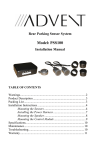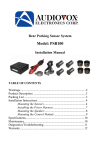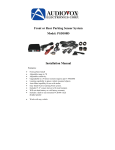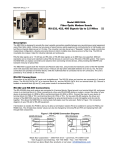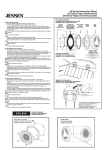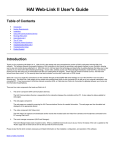Download Audiovox PSD100C Installation manual
Transcript
Front or Rear Parking Sensor System Model: PSD100 / PSD100C Installation Manual TABLE OF CONTENTS Warnings.......................................................................................4 Product Description ......................................................................5 Packing List ..................................................................................6 Installation Instructions ................................................................7 Mounting the Sensors .......................................................7 Installing the Power Harness (REAR)..............................9 Installing the Power Harness (FRONT).........................10 Mounting the Speaker.....................................................11 Mounting the Mute/On-Off Button .................................12 Control Module Dip Switch Settings ..............................12 Mounting the Control Module ........................................13 Setting the Learning System.......................................................14 Specifications..............................................................................15 Maintenance................................................................................15 Troubleshooting..........................................................................15 Warranty .....................................................................................45 1 Features • • • • • • • • • • • Front or rear install Adjustable range to 7ft Adjustable sensitivity Upgradeable to a 4-sensor system (requires part #: PSD200/PSD200C) Learning capability to ignore vehicle mounted objects Auto-mute capability for use with trailer Easy install active learning front system Includes 0° and 8° sensor sleeves to fit most bumpers Will not drain battery or void factory warranty Includes adjustable speaker with tricolor LED Works with any vehicle 2 Warnings This product is intended to assist in safe driving by signaling the driver of the distance to obstacles in close proximity to the vehicle while the vehicle is in reverse or moving forward slowly. You, as the driver, are solely responsible for the safe operation of your vehicle and the safety of your passengers according to your local traffic regulations. Do not use any features of this system to the extent it distracts you from safe driving. Your first priority while driving should always be the safe operation of your vehicle. Audiovox Electronics Corporation cannot accept any responsibility whatsoever for accidents resulting from failure to observe these precautions or safety instructions. 1. This product utilizes high voltage. Any unauthorized modifications or damage to the product may result in electrical shock. Handle all components with care. Inspect regularly for damage to components and cabling. 2. You are responsible for ensuring that the installation of this product does not void or affect the vehicle manufacturer’s warranty. Audiovox Electronics Corporation or its subsidiaries are not liable in full or in part for improper installation resulting in loss or damage to your property, or for voiding all or part of the vehicle manufacturer’s warranty. 3. Do not apply excessive force to any of the components contained within this kit. Excessive force used before, during or after installation that results in a damaged or non-functional part will void all warranties. 4. Please follow the procedures in this installation manual. Improper installation or modification of this product will void all warranties. 3 Product Description This Front or Rear Parking Sensor System is designed to assist the driver by providing an alert when the vehicle is traveling toward a nearby object. Never rely solely on this product to ensure the area is clear of children and/or obstructions. This product is not intended to replace existing safety procedures, but rather to add an additional safety tool for your vehicle. Packing List The model PSD100 Front or Rear Parking Sensor System consists of the following items: 1. 2. 3. 4. 5. 6. Control Module Sensors, 2 each, with 19.68ft length of cable 9-foot power cable Tricolor LED display/speaker with 9ft length of cable Auto-Mute button with 9ft length of cable 2 each of the following sensor sleeves: a) 0 degree b) 8 degree 7. Hardware bag includes: a) 2 tap connectors b) 6 cable ties c) Velcro tape 2pcs (1-module, 1-speaker) d) Alcohol swab pad e) Lock screw for buzzer/LED (speaker) module f) Grounding screw/washer/ring terminal 8. Installation Manual 9. User Manual 4 Installation Instructions Before installing this product, take time to familiarize yourself with the items in the box and use the packing list to verify all parts are present. Mounting the Sensors Choosing the Correct Sensor Sleeve Use the application guide below to determine whether a sensor sleeve will be required. This will affect the diameter of the hole in the bumper. 5 Marking and Drilling Holes Figure 1 (2 sensors) Figure 2 (4 Sensors) 1. Mark the locations of the sensors on the front or rear bumper using a grease pencil. a. Identify the sensors height on the bumper and mark. The sensor height should be between 18” and 30” from the ground. b. Divide the bumper as shown in Figure 1 for a two sensor install, or as shown in Figure 2 for a four sensor install. c. Install the sensors equally from the center of the bumper as shown in Figure 1 and Figure 2. d. Inspect behind the bumper where the sensors are to be located to check for possible obstructions, including metal braces, electrical wires, and clearance. The sensors need 1.5” of clearance behind the bumper to be fully inserted and mounted securely. Do not mount sensors directly above exhaust pipes or with the rear of the sensor contacting metal. Relocate the sensors if any obstruction exists. 2. Before drilling the holes, use a center punch to make a dimple on the bumper to prevent the drill from slipping from the intended mark. 3. Drill the sensor holes. o Use a 26mm Hole Saw if you are using a sensor sleeve. o Use a 13/16” Hole Saw if you are installing without a sensor sleeve. o When drilling a metal bumper, remove the sharp edges using a round metal file. Be careful not to enlarge hole when filing. 6 Installing the Sensor Sleeve and Sensors NOTE: When installing the sensors into the sensor sleeves, push on the outer ring of the sensor only. Never push on the center of the sensor. 1. Ensure sensors and sleeves are upright (all products have an alignment mark on the top). 2. If required, install the sensor into the sleeve. 3. Install the sensor (with sleeve, if required) into the holes drilled in the bumper. 4. Run the sensor wires through the sensor sleeves in the bumper. 5. Press on the outer ring of the sensor and push until the sensor is flush with the bumper. The sensor should fit snugly into the bumper and lock into place. 6. Determine where the sensor wires will enter into the trunk area or passenger compartment. Many vehicles have a factory grommet to allow routing of wires from the outside to the inside of the vehicle. If needed, drill a hole to route the wires into the vehicle, taking care when drilling metal. Smooth edges with a round metal file and use a rubber grommet to protect the wires. 7. Feed the sensor wires through the factory grommet or other opening into the vehicle for connection to the control module (e.g., into the cab of most trucks or the trunk of passenger cars). NOTE: Once the wires are passed through, make sure there is enough wire to route to the control module. Check that the sensor wires will not be pinched by moving parts or panels. 8. Cable tie the sensor wires and the power harness wires behind the bumper, keeping them away from the exhaust system or moving suspension parts (install power harness before using cable ties). Do not pull on the sensor wires near the sensor shaft exit point, as this may damage the inner connections. 7 Installing the Power Harness (REAR) Tap/Run Connection 1. 2. REAR SENSORS - POWER HARNESS INSTALL. For installation in the REAR of the vehicle, locate a source of reverse power (usually at taillight assembly) and accessory power (usually cigarette lighter). a) REVERSE POWER Using the tap connector supplied, perform the following steps: i. Place the un-stripped positive reverse power lead wire on the run channel. ii. Insert the un-stripped RED power wire completely. iii. Make the connection between the wires by crimping down the metal connector with a pair of pliers, making sure the metal is flush with the plastic insulator. iv. Close the top hinged cover until latched. b) GROUND The ground wire should be secured directly to the vehicle body or to a ground wire directly attached to the vehicle body. Using the tap connector supplied, perform the following steps: i. Place the un-stripped ground (earth) lead wire on the run channel. ii. Insert the un-stripped BLACK power wire completely. iii. Make the connection between the wires by crimping down the metal connector with a pair of pliers, making sure the metal is flush with the plastic insulator. iv. Close the top hinged cover until latched. c) ACCESSORY POWER i. Place the un-stripped accessory lead wire on the run channel. ii. Insert the un-stripped ORANGE ground wire completely. iii. Make the connection between the wires by crimping down the metal connector with a pair of pliers, making sure the metal is flush with the plastic insulator. iv. Close the top hinged cover until latched. Route the power harness wires with the sensor wires to the control box. 8 Installing the Power Harness (FRONT) Tap/Run Connection 1. 2. FRONT SENSORS - POWER HARNESS INSTALL. For installation in the FRONT of the vehicle, locate a source of accessory power (usually cigarette lighter). a) ACCESSORY POWER i. Place the un-stripped accessory lead wire on the run channel. ii. Insert the un-stripped RED ground wire completely. iii. Make the connection between the wires by crimping down the metal connector with a pair of pliers, making sure the metal is flush with the plastic insulator. iv. Close the top hinged cover until latched. b) GROUND The ground wire should be secured directly to the vehicle body or to a ground wire directly attached to the vehicle body. Using the tap connector supplied, perform the following steps: i. Place the un-stripped ground (earth) lead wire on the run channel. ii. Insert the un-stripped BLACK power wire completely. iii. Make the connection between the wires by crimping down the metal connector with a pair of pliers, making sure the metal is flush with the plastic insulator. iv. Close the top hinged cover until latched. Route the power harness wires with the sensor wires to the control box. 9 Mounting the Speaker The speaker has three volume settings: Off, Hi, and Low. Since the speaker can be adjusted as needed, you should mount the speaker in an accessible location in the interior. It is recommended that the speaker for the Rear detection system is mounted behind the driver and that the Front detection system is mounted in front of the driver. 1. Route the wires for the speaker to the area where you will install the control module. Make sure they will not be pinched by the panel or moving parts. 2. Clean the back of the speaker and the mounting location to ensure good adhesion. When the location is dry, peel the backing strip off the Velcro tape and place on the back of the speaker. Next, peel the backing strip off the other side of the Velcro tape and press on the cleaned surface. Use the optional mounting screws (provided), if necessary. 10 Mounting the Mute/On-Off Button The PSD100 system has an optional mute/on-off switch. When installed with a rear system, the button will mute the rear PSD system until the ignition is turned off and back on. When installed on a front sensor system, the button serves as an on/off switch for front detection. To install the Mute/On-Off button: 1. Determine a suitable place to mount the button. 2. Route the wires for the button to the area where you will install the control module. Make sure they will not be pinched by the panel or moving parts. 3. Check the area behind the button location to ensure it is clear of obstacles. Drill a 10mm diameter hole for the button, 4. Mount the button and secure with the supplied locking ring. 5. Attach the cable connecting the button to the module. Control Module Dip Switch Settings The PSD100 has a number of settings. You can modify these settings at any time. SETTING UP SWITCH 1 Rear Bumper SWITCH 2 4 Sensor DOWN Front Bumper 2 Sensor 11 SWITCH 3 Full Detection (7ft) Normal Detection (5ft) SWITCH 4 High Sensitivity (general use) Low Sensitivity (use if required to remove ground detection) Mounting the Control Module Determine a dry place inside the vehicle (out of the way) to mount the control module (e.g., behind an inner body panel), making sure that all wiring will reach the intended location. 1. Plug the sensor wires, speaker and power harness into the control module before mounting. The sensor must be plugged into the corresponding socket (see Figure 4). The control module is pre-fitted with Velcro for mounting. 2. Clean the pre-selected mounting area to ensure good adhesion. 3. When the surface is dry, peel the backing off the Velcro pad and attach the control module. LS – Left Side Sensor (only used in 4 sensor install) RS – Right Side Sensor (only used on a 4 sensor install) Figure 4 12 Setting the Learning System (Rear Sensors) If an object mounted on the vehicle is causing the Rear sensor system to false alarm (tow bar, rear mounted tire, bicycle rack etc.) you can ‘train’ the PSD system to ignore these obstacles. 1. Place the vehicle in an area at least 15ft away from obstacles. 2. Start the engine and leave it running. 3. Place the vehicle in and out of reverse gear 4 times at 1-2 second intervals, ending with the vehicle in reverse. When the vehicle enters learning mode, the LED display will display RED-ORANGE-GREEN alternately for 10 seconds silently. The system will then beep for 1 second to confirm that the ‘training’ was successful. 4. Once ‘trained’, whenever the vehicle is placed in reverse the LED will flash orange and then green and the system will beep once to alert the driver that part of the detection area is being ignored. The learning system can be re-trained at any time by performing the training cycle explained above. The system can be reset to default by removing the vehicle mounted obstacle and performing the training cycle. Once the learning system has been reset, when placed in reverse, the system will only flash green once (showing that there is no area in the detection zone being ignored). 13 Specifications Power Supply Current Draw Detecting Distance Sensor Cable Length Operating Temperature Range DC9V-DC16V <120mA 0ft – 7ft 19.68ft -0°F ~ 176°F Maintenance Though your backup system requires minimum care, you should maintain its condition and performance using the following the guidelines: • Keep the control box away from moisture, extreme heat or cold. • Keep the sensors free from snow, ice, and debris. Diagnostics / Trouble Shooting Problem No sound when reverse gear is engaged. 1 Beep 2 Beeps 3 Beeps 4 Beeps System beeping without obstacle behind vehicle Solution 1. Check if ignition/reverse light on 2. Check power cable connection 3. Check switch on speaker Rear system is functioning correctly 1 sensor is disconnected/damaged 2-3 Sensors are disconnected/damaged No sensors are connected 1. Ensure sensor is mounted upright. 2. Remove anything mounted on the vehicle that may be in the detection area. 3. Verify sensor is installed at the correct height. 4. Verify sensor is in the correct position. 5. Check all connections. 6. Ensure module is not mounted near electrical components with high current. 7. Verify supporter was used if required (angled/metal bumpers). 14 15 © 2008 Audiovox Electronics Corp., 150 Marcus Blvd., Hauppage, NY 16

















